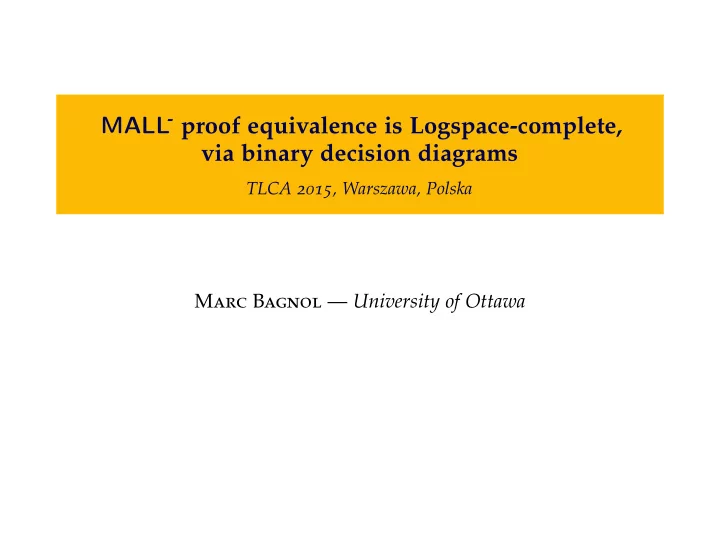

- proof equivalence is Logspace-complete, MALL via binary decision diagrams TLCA 2015 , Warszawa, Polska M arc B agnol — University of Ottawa
Rule permutations and the equivalence problem Permutations: in sequent calculus presentation of a logic we have a number of permutation equivalences, such as � π � � π � A , B , C , D A , B , C , D ∼ � � A � B , C , D A , B , C � D � � A � B , C � D A � B , C � D - ) or more specifically ( MALL � π � � µ � � π � � ν � � µ � � ν � A , C B , C A , C D B , C D � ν � ∼ ⊗ ⊗ � A � B , C D A , C ⊗ D B , C ⊗ D ⊗ � A � B , C ⊗ D A � B , C ⊗ D These permutations mirror the commutative conversions of the cut-elimination procedure in sequent calculus. - equiv ) Equivalence problem ( MALL - proofs π and µ , are they related by permutations? Given two MALL 2 / 10
Proofnets Proofnets (Girard): canonical combinatorial objects for equivalence classes. Motivation: better understanding of the logic, finer study of its cut-elimination procedure. - ) enjoy a completely satisfactory notion of proofnet. A few logics ( MLL In many cases: open problem. Heijltjes, Houston: settled the case of MLL with unit, negatively. Method: study and determine the complexity of the equivalence problem. In the case of MLL with units it is Pspace -complete. 3 / 10
- Proofnets for MALL Monomial nets (Girard): based on boolean weights attached to the edges of the net, Ptime but not canonical. Slice nets (Hughes & Van Glabbeek): set of slices, i.e. different “versions” of the net. Canonical but exponential blow-up. - both In an unpublished note, Hughes argues that a notion of proofnet for MALL Ptime and canonical is unlikely to exist. We study the equivalence problem to determine whether we get the same type of impossibility result as in MLL with units. 4 / 10
Binary Decision Diagrams First (wrong) intuition: the missing step in canonicity for monomial nets amounts to equivalence of boolean formulas ( coNP -complete). A closer look reveals that these net involve only a specific type of formulas, that we call binary decision diagrams ( BDD ). Definition A BDD is a binary tree with nodes labeled by boolean variables and leaves labelled by 1 and 0 . Subclass: o BDD read the variables in a specified order. (can be seen as boolean formulas built only with a If x Then · Else · construction) Two BDD are equivalent ( φ ∼ ψ ) if they give the same answers for all assignments of variables (e.g. If x Then 1 Else 1 ∼ 1 .) 5 / 10
BDD slicings An intermediate notion between monomial nets and slice nets. � π � �→ B π Γ Basic idea: to each � connective in Γ associate a boolean variable. To each pair of dual atoms α , α ⋆ in Γ associate a BDD . Example: β , β ⋆ α , α ⋆ B π [ α , α ⋆ ] = If x Then 1 Else 0 ⊕ l ⊕ r π = α ⊕ β , α ⋆ α ⊕ β , β ⋆ B π [ β , β ⋆ ] = If x Then 0 Else 1 � x α ⊕ β , α ⋆ � x β ⋆ Equivalence: define B ∼ B ′ as B [ α , α ⋆ ] ∼ B ′ [ α , α ⋆ ] for all α , α ⋆ . Theorem We have π ∼ µ if and only if B π ∼ B µ . 6 / 10
A chain of reductions (I) The notion of BDD slicing gives a reduction: - equiv → BDD equiv MALL Then we can obtain - equiv o BDD equiv → MALL - proof mimicking the tree structure. by encoding ordered BDD with a MALL Relies on the ⊗ / � rule commutation. 7 / 10
A chain of reductions (II) We complete the chain by considering the Logspace -complete problem ORD : Given a line graph G , two vertices f and s , do we have f < s in the induced total order? It reduces to o BDD equiv : f + s + b · · · f · · · s · · · 1 y f + s + x b · · · f · · · s · · · 0 y f + s + b · · · f · · · s · · · 0 Lemma The following chain of (AC 0 ) reductions holds: - equiv → → → ORD o BDD equiv MALL BDD equiv 8 / 10
The main theorem The restricted nature of BDD makes their equivalence sit far below coNP . Lemma The equivalence of BDD problem ( BDD equiv ) is in Logspace. - equiv : Summing up, the complexity of MALL Theorem - equiv → → → ORD o BDD equiv MALL BDD equiv ( Logspace -hard) ( ∈ Logspace ) - is Logspace-complete. Therefore the equivalence problem for MALL 9 / 10
Conclusion Equivalence can be decided efficiently. This does not settle the question of proofnets: building a canonical representative efficiently is stronger than solving equivalence efficiently. Some ideas for an impossibility result: (?) ◦ canonical representative ◦ cut-elimination ◦ optimization problems for BDD . . . T hank you for your attention ! 10 / 10
Recommend
More recommend